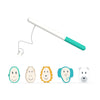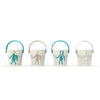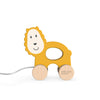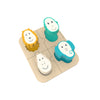Naptime Natters for Babies & Toddlers: Your Questions Explained
Who doesn’t love a nap? Babies and toddlers are certainly no different. At the rate their bodies are growing, we think they deserve to recharge their batteries every so often - don’t you?
In fact, it is suggested that a newborn baby could benefit from sleeping for up to 16 hours a day.
Simplifying the napping minefield
When it comes to napping, the questions and opinions are endless; especially when it comes to the who, what, when, where, why and even hows of napping, but try not to fret.
We at Matchstick Monkey like to consider the answers to your questions to be suggestions. We believe it is unlikely that there is a textbook answer for napping and every child is different.
However, there are a few helpful hints we have come across, which could help you gauge your expectations and guide you through the napping minefield, so let’s get started.
How many naps per day does my child need?
4 months - 1 year old

If your little one falls between the ages of 4 months to 1 year, your baby will likely rest their eyes at least twice a day. Typically, this would be once in the morning and once in the early afternoon. If your baby has used lots of energy during the day, they may even like to squeeze in a late-afternoon nap.
You could aim to have your bundle of joy nap at 9am and then again at 1pm. Let them nap for as long as they want, unless they can be restless at night, in which case you could try to keep their naps around an hour long.
By 9 months, if your baby is still taking a sneaky late-afternoon nap, you could try to eliminate this if you like, so they can instead get ready for an earlier bedtime.
1 year old +

When your baby hits the 10 months to 1 year old mark, they will likely drop their morning nap. This may cause a little bit of change in their routine, but keep positive, it shouldn’t be drastic.
During this time, you could consider tweaking your baby’s nap time and bedtime by half an hour later to help them adjust.
When it comes to afternoon naps, some babies will enjoy taking a 1-2 hour kip until the age of 3. At the age of 3, their nap lengths tend to shorten or they might no longer take a nap if they are busy at playgroup or preschool.
How should I put my baby down for a nap?

To settle your baby into nap time, you could try the following:
- Create a calming environment - a dark, quiet environment can help encourage your baby to sleep.
- Lie your baby down when they are drowsy, but awake - before your baby gets overtired, you might treat them to a soft lullaby, white noise or swaddle or massage them. Eventually, your baby will associate these activities with rest.
- Keep safety in mind - place your baby to sleep on their back, and make sure the cot or bassinet is clear of blankets and other soft items.
- Keep things consistent, where possible - your baby will get the most out of daytime naps if they take them at the same time each day and for about the same length of time. Occasional exceptions are inevitable, of course, and won't harm your baby.
What if my baby is restless at naptime?

If your baby appears restless when you’re trying to put them down for a mid-morning or afternoon nap try not to panic. This is not uncommon. Perhaps for a newborn, a soothing white noise might help to soothe them or a gentle rock.
For babies between 4 months and over, they may be able to self-soothe and put themselves over within a few minutes, if you stand at the door.
Remember, every baby is different and nap schedules can vary
Yes there may be guidelines for napping, but don’t undermine your instinct when it comes to a topic like this. No one knows your little one quite like you, and as the age old saying goes “a mother or father often knows best”.





























